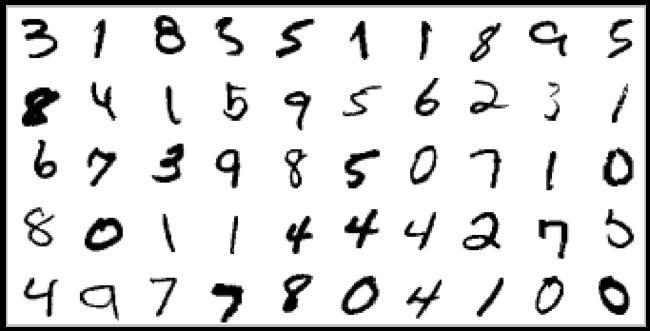在具备了一定的基础知识后,我们终于可以开始动手构建卷积神经网络了。根据TensorFlow官网上的教程,A Guide to TF Layers: Building a Convolutional Neural Network,我们先来学习怎样使用TF中的layers模块构建一个简单的卷积神经网络来识别手写数字(handwritten digits)。我们用到的数据集(手写数字0-9的黑白图片)来自MNIST( http://yan.lecun.com ),总共包括60000个训练数据和10000个测试数据,图片的大小为28×28像素。教程的完整代码(cnn_mnist.py)可以在github上找到。
我们首先尝试构建一个简单的卷积神经网络,它的结构如下:
- Input Layer
- Convolutional Layer #1:32个5×5的filter,使用ReLU激活函数
- Pooling Layer #1:2×2的filter做max pooling,步长为2
- Convolutional Layer #2:64个5×5的filter,使用ReLU激活函数
- Pooling Layer #2:2×2的filter做max pooling,步长为2
- Dense Layer #1:1024个神经元,使用ReLU激活函数,dropout率0.4 (为了避免过拟合,在训练的时候,40%的神经元会被随机去掉)
- Dense Layer #2 (Logits Layer):10个神经元,每个神经元对应一个类别(0-9)
我们在cnn_mnist.py的代码中可以看到,构建CNN模型的任务是通过cnn_model_fn函数来实现的:
def cnn_model_fun(feature, labels, mode):
"""Model function for CNN."""
......
在这个函数中,我们用TensorFlow的layers模块一步步构建卷积神经网络。主要用3个method:conv2d(),max_pooling2d()和dense()来分别创建Convolutional Layer,Pooling Layer和Dense Layer。除此之外,我们还要定义loss function,配置training op,并生成预测值。
下面将逐段分析cnn_model_fn函数的代码。
Input Layer
# Input Layer
# Reshape X to 4-D tensor: [batch_size, width, height, channels]
# MNIST images are 28x28 pixels, and have one color channel
input_layer = tf.reshape(feature, [-1, 28, 28, 1])
输入层的tensor(input_layer)一共有4个dimension,分别是:[ batch_size, image_width, image_height, channels]
batch_size:每次训练使用的训练集的子集的大小
image_width:图像的宽
image_height:图像的高
channels:彩色图像值为3,黑白图像值为1
我们将大小为28×28的黑白照片通过feature参数传递进来(每个值代表一个像素),然后reshape成4-D的输入层tensor。batch_size取-1表示该值是在其他3个值不变的情况下,根据feature的长度动态计算出的。这样做的好处是可以把batch_size作为一个可以调的hyperparameter。
Convolutional Layer #1
# Computes 32 features using a 5x5 filter with ReLU activation.
# Padding is added to preserve width and height.
# Input Tensor Shape: [batch_size, 28, 28, 1]
# Output Tensor Shape: [batch_size, 28, 28, 32]
conv1 = tf.layers.conv2d(
inputs=input_layer,
filters=32,
kernel_size=[5, 5],
padding='same',
activation=tf.nn.relu)
我们使用conv2d来创建卷积层。在这一层中,我们需要32个5×5的filter,并且使用ReLU激活函数。padding=‘same’的意思是:通过zero-padding的办法,保证input和output tensor的大小一致。其他参数都很好理解。输出的tensor的shape为[batch_size, 28, 28, 32],现在的channel数为32,每个channel对应一个filter的输出。
Pooling Layer #1
# First max pooling layer with a 2x2 filter and stride of 2
# Input Tensor Shape: [batch_size, 28, 28, 32]
# Output Tensor Shape: [batch_size, 14, 14, 32]
pool1 = tf.layers.max_pooling2d(inputs=conv1, pool_size=[2, 2], strides=2)
我们使用max_pooling2d来创建pooling层。在这一层中,我们需要2×2的filter做max pooling,步长为2。输出的tensor的shape为[batch_size, 14, 14, 32]。
Convolutional Layer #2 and Pooling Layer #2
根据同样的方法创建,代码如下:
# Convolutional Layer #2
# Computes 64 features using a 5x5 filter.
# Padding is added to preserve width and height.
# Input Tensor Shape: [batch_size, 14, 14, 32]
# Output Tensor Shape: [batch_size, 14, 14, 64]
conv2 = tf.layers.conv2d(
inputs=pool1,
filters=64,
kernel_size=[5, 5],
padding='same',
activation=tf.nn.relu)
# Pooling Layer #2
# Second max pooling layer with a 2x2 filter and stride of 2
# Input Tensor Shape: [batch_size, 14, 14, 64]
# Output Tensor Shape: [batch_size, 7, 7, 64]
pool2 = tf.layers.max_pooling2d(inputs=conv2, pool_size=[2, 2], strides=2)
conv2的shape为[batch_size, 14, 14, 64],pool2的shape为[batch_size, 7, 7, 64]
Dense Layer
# Flatten tensor into a batch of vectors
# Input Tensor Shape: [batch_size, 7, 7, 64]
# Output Tensor Shape: [batch_size, 7 * 7 * 64]
pool2_flat = tf.reshape(pool2, [-1, 7 * 7 * 64])
在构建dense层之前,我们先把pool2的dimension从4变成2,也就是把shape改为[batch_size, 7 × 7 × 64]。
# Dense Layer
# Densely connected layer with 1024 neurons
# Input Tensor Shape: [batch_size, 7 * 7 * 64]
# Output Tensor Shape: [batch_size, 1024]
dense = tf.layers.dense(inputs=pool2_flat, units=1024, activation=tf.nn.relu)
接下来我们用dense方法来创建dense层,一共有1024个神经元,并且使用ReLU激活函数。dense的shape为[batch_size, 1024]。
然后对dense层使用dropout regularization:
# Add dropout operation; 0.6 probability that element will be kept
dropout = tf.layers.dropout(inputs=dense, rate=0.4, training=mode == learn.ModeKeys.TRAIN)
mode指的是模型运行的模式,有三种:TRAIN,EVAL和INFER。当mode为TRAIN的时候,training参数为True,dropout才能执行。dropout tensor的shape为[batch_size, 1024]
Logits Layer
# Logits layer
# Input Tensor Shape: [batch_size, 1024]
# Output Tensor Shape: [batch_size, 10]
logits = tf.layers.dense(inputs=dropout, units=10)
这是神经网络的最后一层,返回的是我们预测的原始值。用10个神经元对应0-9十个数,激活函数使用的是默认值(线性激活函数)。logits的shape是[batch_size, 10]。
Calculate Loss
在训练(TRAIN)和评估(EVAL)的时候,我们需要定义一个损失函数(loss function)来衡量模型的预测值和真实值之间的距离。对于多元分类问题,我们通常使用cross entropy来作为loss。
loss = None
train_op = None
# Calculate loss for both TRAIN and EVAL modes
if mode != learn.ModeKeys.INFER:
onehot_labels = tf.one_hot(indices=tf.cast(labels, tf.int32), depth=10)
loss = tf.losses.softmax_cross_entropy(
onehot_lables=onehot_lables, logits=logits)
为了计算cross-entropy,我们首先要用tf.one_hot函数把图像的labels([1,3,4,9,...])转成one-hot encoding格式。tf.losses.softmax_cross_entropy函数先在logits上使用softmax激活函数(得到每个class的概率),然后计算onehot_lables和logits之间的cross-entropy。
Configure the Training Op
# Configure the Training Op (for TRAIN mode)
if mode == learn.ModeKeys.TRAIN:
train_op = tf.contrib.layers.optimize_loss(
loss=loss,
global_step=tf.contrib.framework.get_global_step(),
learning_rate=0.001,
optimizer="SGD")
在定义了loss后,我们要告诉TF如何在训练中优化这个loss。我们使用的是tf.contrib.layers.optimize_loss函数,学习速率设为0.001,优化算法是随机梯度下降(Stochastic Gradient Descent,SGD)。
Generate Prediction
# Generate Predictions
predictions = {
"classes": tf.argmax(input=logits, axis=1),
"probabilities": tf.nn.softmax(logits, name="softmax_tensor")
}
Logits Layer 返回的logits是预测的原始值,我们需要将其转换成预测的类别(classes)和概率(probabilities)。对于每个example来说,我们预测的类别就是原始值最高的那个类,可以用tf.argmax函数来获得。在logits上使用softmax激活函数tf.nn.softmax可以得到每个类的概率。
ModelFnOps object
# Return a ModelFnOps object
return model_fn_lib.ModelFnOps(mode=mode, predictions=predictions, loss=loss, train_op=train_op)
最后,我们将得到的predictions,loss,train_op和mode参数一起放到ModelFnOps对象中并作为cnn_model_fun函数的返回值。
创建完CNN模型函数cnn_model_fun后,我们就可以开始对模型进行训练和评估。这部分代码在main()函数中:
def main(unused_argv):
......
下面将逐段分析main函数的代码。
Loading Training and Test Data
# Load training and eval data
mnist = learn.datasets.load_dataset("mnist")
train_data = mnist.train.images # Returns np.array
train_labels = np.asarray(mnist.train.labels, dtype=np.int32)
eval_data = mnist.test.images # Returns np.array
eval_labels = np.asarray(mnist.test.labels, dtype=np.int32)
TF会自动下载MNIST数据集,并将训练集(train)和测试集(eval)的原始像素值(data)和标签(labels)存放在numpy arrays中。
Create the Estimator
# Create the Estimator
mnist_classifier = learn.Estimator(model_fn=cnn_model_fn, model_dir="/tmp/mnist_convnet_model")
Estimator是TF对模型进行训练(training),评估(evaluation)和推断(inference)所用的类。model_dir参数用来指定模型数据和检查点(checkpoints)的存放路径。
Set Up a Logging Hook
# Set up logging for predictions
# Log the values in the "Softmax" tensor with label "probabilities"
tensors_to_log = {"probabilities": "softmax_tensor"}
logging_hook = tf.train.LoggingTensorHook(tensors=tensors_to_log, every_n_iter=50)
由于CNN的训练时间比较长,我们需要TF输出logging来跟踪训练的进程。在上面的例子中,我们使用tf.train.LoggingTensorHook,要求每训练50次的时候输出预测的概率值。
Train the Model
# Train the model
mnist_classifier.fit(
x=train_data,
y=train_labels,
batch_size=100,
steps=20000,
monitors=[logging_hook])
我们现在可以用mnist_classifier的fit()方法进行模型的训练。feature和labels分别传递给x和y,batch_size=100的意思是模型每次(step)在由100个样本组成的小训练集上进行训练,steps=20000表示模型总共训练20000次。将logging_hook传递给monitors参数可以在训练的时候输出我们指定的logging。
Evaluate the Model
训练结束后,我们要对模型的准确率进行评估。首先用MetricSpec设定准确性的度量标准(accuracy metric):
# Configure the accuracy metric for evaluation
metrics = {
"accuracy":
learn.MetricSpec(
metric_fn=tf.metrics.accuracy, prediction_key="classes"),
}
然后将评估数据集(eval_data和eval_labels)和metric传给mnist_classifier的evaluate方法,得到最终的评估结果。
# Evaluate the model and print results
eval_results = mnist_classifier.evaluate(x=eval_data, y=eval_labels, metrics=metrics)
print(eval_results)
Run the Model
运行cnn_mnist.py脚本,训练模型并得到最终的准确率。
我算出的准确率为96.9%,比教程中的略低(97.3%)。

